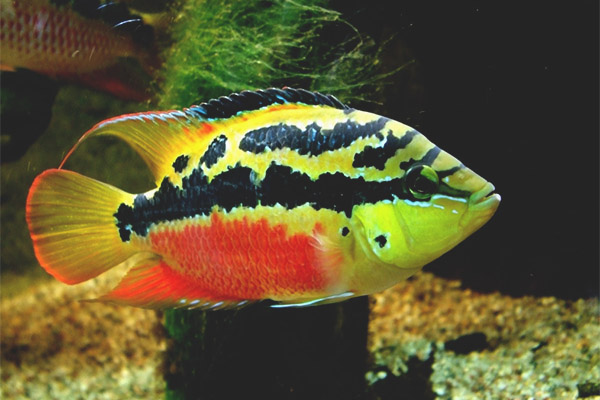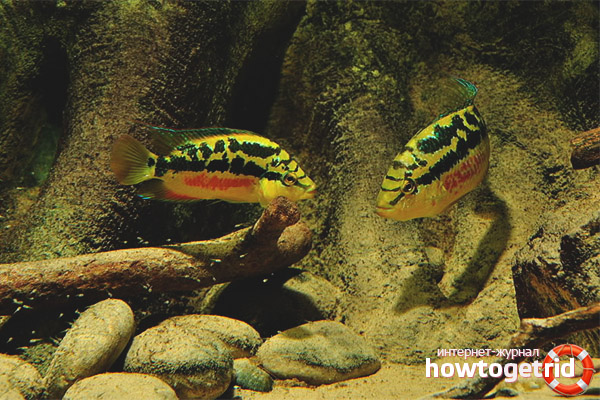The content of the article
There are many supporters of aquarium fish, for which we have prepared today's material. Tsikhlazoma salvini seems homely fish, but it is only at a young age. When an individual grows up, it acquires bright outlines, it is difficult to look away from such a beauty. This species is ideal for maintenance in aquarium conditions, care does not require special knowledge and skills. Therefore, today we will consider all the main aspects affecting this type of fish.
Features and origin
Otherwise, the specimens of the species presented are called yellow-bellied. They appeared in the United States back in 1911. From America, the fish migrated to Germany, and a little later the aquarists of Mexico enjoyed it. The description of the species originates in 1862, since then the characteristics have changed, but not much.
Fish prefer to inhabit the region of the Atlantic Ocean in the basins of lagoons and rivers.They swim throughout, stop to rest in shady places near the jungle and forests. Due to its habitat in this area, the color is always bright and does not lose its “juiciness”.
It is highly undesirable to contain salvini with smaller fish that have a peace-loving character. The point is not that they will be eaten. Tsikhlazoma will drive a neighbor into a corner and scare him to horror.
Description
- It cannot be said that the specimens presented are too large, but the length of the body of 18 cm to inexperienced aquarists may seem impressive. This applies to males, samochki less (about 14 cm).
- As a rule, the small size of the females do not make the fish dull. On the contrary, they are colorful, neat and stand out from the crowd. The most juicy colors in the area of the belly and back, there are marked marks in red. Males are a little dimmer, but still paints are present.
- Regardless of which sex you are talking about, they are all pigmented in yellow (background). On the side there is a dark color band; above it, in the area of the back, there are marks on the tone that coincide with the stripe.
- When it comes to males that live in the Candelaria (Mexico) speech area, they are on the list of exceptions in beauty. That is, in this case, the male sex is much more beautiful than the female. The abdominal zone is pigmented with a red tinge, bright, saturated.
- It is difficult for an unprepared person to distinguish a female from a male. In the beautiful ladies in the middle of the fin on the back there are specks of black color with blue edging. By themselves, they are bright, the males are duller, preferably of a blue tone. Male items have a mark on the upper part of the lip, and there is a line on the side.
- Also about the differences between individuals of different sexes we can say the following: males have pointed and elongated fins, while females have a dark mark (spot) on the gills.
Content
- There are no special difficulties with the content. Usually, all problems arise because these fish do not get along with their neighbors. According to experienced aquarists, individuals can only live in pairs. They need about 200 liters. water. If the number of individuals increases, it is necessary to add another 40 liters to each fish. water.
- Absolutely any option is suitable as a primer. But the ideal solution would be lining the bottom with granite chips or pebbles of the smallest size. It will be necessary to plant greens with the most powerful roots, therefore the layer of soil should not be less than 8-10 cm.
- Fish love to be in the shade, to be in silence, so take care of shelters. Stones, snags, special houses - everything will do. Since the fish will attack the plants, only specimens with a strong root system should be planted. As an option, consider echinodorus or cryptocoryne.
- The important conditions of detention include temperature, which should not go beyond the boundaries of the situation. Keep pets at rates of 24-26 degrees. Take care of the "correct" acidity - pH 7-8.5.
- Representatives of this breed do not like light, so they always try to hide in the shadows. This allows the fish to retain color. Therefore, do not install powerful lamps, so that the inhabitants do not hide from the lighting. Enough indicator of 0.3 watts with a calculation of 1 liter. water. Once every 7–10 days, 30% of the total volume of water is replaced.
Breeding
- By the year of life, the species of fish considered becomes mature. The subspecies of the cichlidae are monogamous, which is why the couple is created at the age of six months. The female can spawn in the general aquarium or in a special spawning. The last option is the most preferred.
- The problem is that during spawning, the fish presented become quite aggressive. Because of this, cichlids begin to drive away all the inhabitants of the aquarium from the nest where the eggs are. Therefore, in order to prevent this, parents should be transplanted to another tank in advance.
- Separately, it is worth mentioning the fact why spawning should occur in a separate tank - this is what the fish get a lot of stress if they lose their offspring. Because of this, the male is very angry and can kill his doe during a skirmish. After that, the male himself dies, due to the awareness of loneliness.
- Consider that the aquarium for spawning must be at least 100 liters. Without fail at the bottom of the tank must be various shelters. So take care of this in advance. Sometimes the male can independently create a nest in the open area.You need to cover it from above with some arch or snag. Algae or Javanese moss will do.
- If you do not cover the nest or this cannot be done for any reason, the spawning is often delayed for a long time. To stimulate spawning, experts recommend to increase the temperature of the water in the aquarium by several degrees. Do everything necessary so that the offspring appears as quickly as possible.
- Tsikhlazomy produce throwing caviar on the surface of snag or stone. Interesting fact, the number of eggs per spawning can reach up to 500 units. In this case, the incubation period lasts only 2-3 days. After the allotted time, the fry are quite large in size.
- After a few more days, the young fish can independently feed and swim without difficulty. Fry will look for food in the algae. Often they feed on the remnants of uneaten food that remains from their parents. Young animals are recommended to be fed with a special starter feed.
- Often the fry are given nauplin artemia. In addition, young animals are recommended to be additionally fed with a pipe maker, which should be finely chopped in advance.Such feed should be introduced into the diet after the fry have turned more than 1 week.
- In an aquarium where young animals are kept, the temperature should be strictly observed. Water temperature should not fall below 26 degrees. She should stick at about this mark. If the temperature drops below, in most cases the fry die.
- Parents continue to care for young for quite a long time. To once again never to worry, do not rush adult fish to replant in a common aquarium. Let them stay with the fry for a while. Parents should be transplanted only if one of them begins to show aggression towards the young.
Under tsikhlazomoy salvini refers to a fish that protects its territory and does not want to share it with its neighbors. Therefore, in violation of personal space, an adult individual may well show aggression. Carefully select the neighborhood.
Video: Cichlasoma salvini (Cichlasoma salvini)













To send